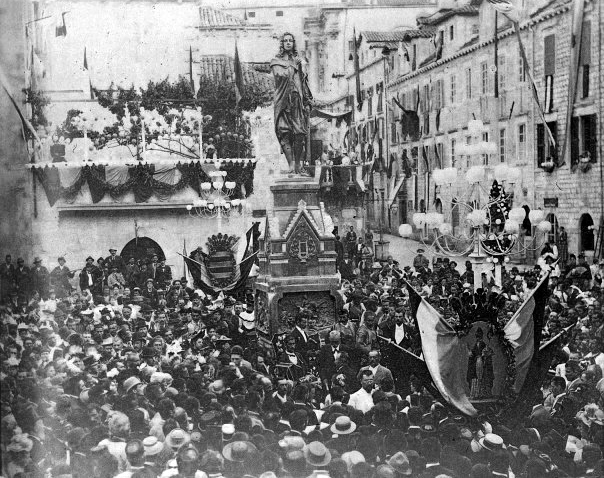Unveiling Of The Gundulić Monument on:
[Wikipedia]
[Google]
[Amazon]
 The unveiling of the Gundulić monument in
The unveiling of the Gundulić monument in
Dubrovnik
Dubrovnik, historically known as Ragusa, is a city in southern Dalmatia, Croatia, by the Adriatic Sea. It is one of the most prominent tourist destinations in the Mediterranean Sea, Mediterranean, a Port, seaport and the centre of the Dubrovni ...
on May 20, 1893, was a symbolical event in the political history of Dubrovnik, since it brought to the surface the wider tensions between the two political sides of the city, the Croats
The Croats (; , ) are a South Slavs, South Slavic ethnic group native to Croatia, Bosnia and Herzegovina and other neighboring countries in Central Europe, Central and Southeastern Europe who share a common Croatian Cultural heritage, ancest ...
and the Serb-Catholics in the pre-World War I
World War I or the First World War (28 July 1914 – 11 November 1918), also known as the Great War, was a World war, global conflict between two coalitions: the Allies of World War I, Allies (or Entente) and the Central Powers. Fighting to ...
political struggles in the region.
The preparation
At its session of March 9, 1880, the Municipal Council of Dubrovnik adopted the proposition received from the "Dubrovnik Youth", an organization known as part of the Serb-Catholic movement in Dubrovnik, to raise a monument for the 300th anniversary of the birth of Gundulić in 1888. The mayor of the city at the time was Rafael "Rafo" Pucić. It was decided that a five-member committee would be nominated to oversee the monument's construction. The members were esteemed intellectuals Medo Pucić, Pero Budmani, Ivo Kaznačić, Mato Vodopić and Luko Zore. In 1882, the budget for the monument's erection was 11,000 florins. In 1882, the oversight committee president Medo Pucić died, as did Ivan August Kaznačić in 1883. Mato Vodopić relinquished his membership when he was namedBishop
A bishop is an ordained member of the clergy who is entrusted with a position of Episcopal polity, authority and oversight in a religious institution. In Christianity, bishops are normally responsible for the governance and administration of di ...
in 1882, and Budmani also left the committee to focus on his work for the Academy's Dictionary; the work was hampered by lack of funding as well.
When the political coalition of the Serb-Catholic and Autonomist party members re-initiated work on it, the committee was reconstituted in 1891 with new members Marinica Giorgi, Lujo Bizzarro, Niko Bošković, Ivo Bogoević, Luko Bona, Brnja Caboga, Baldo Kostić, Vlaho Matijević, Jero Pugliesi, Stijepo Tomašević, Luko Zore and Nikola Ucov. The budget for the monument's erection was increased to 15,800 florins. The new committee organized new ways of funding, advertised the effort in newspapers and among various dignitaries, even reaching out to the emigrants in Argentina
Argentina, officially the Argentine Republic, is a country in the southern half of South America. It covers an area of , making it the List of South American countries by area, second-largest country in South America after Brazil, the fourt ...
.
The monument was erected on May 20, 1893, in Dubrovnik's largest square, Poljana. It was made by the Croatian sculptor Ivan Rendić.
The unveiling
The unveiling, like all the official celebrations in that period, was not only cultural, but also strongly national and political. The members of theCroatian Party of Rights
The Croatian Party of Rights (, HSP) is an Extra-parliamentary opposition, extra-parliamentary Croatian nationalism, nationalist and Neo-fascism, neo-fascist List of political parties in Croatia, political party in Croatia. The word "right(s)" i ...
and the Croatian People's Party tried to bring as many Croats as possible from various Croat regions to give the occasion a Croatian national and political character. On the other hand, the members of the Serb Party
The Serbs ( sr-Cyr, Срби, Srbi, ) are a South Slavs, South Slavic ethnic group native to Southeastern Europe who share a common Serbian Cultural heritage, ancestry, Culture of Serbia, culture, History of Serbia, history, and Serbian lan ...
(Serb-Catholics) tried to gather as many Serbs-Catholics as possible to give a Serbian flavor to the celebration. Thus, the gathering became a symbol of division between opposing national movements.
It was officially revealed on July 26, 1893, by the last male member of the family, Baron Frano Getaldić-Gundulić (''see'' House of Gundulić).
References
Sources
*Further reading
* * {{DEFAULTSORT:Unveiling of the Gundulic monument History of Dubrovnik Political history of Croatia 1893 in Croatia 1893 in politics Serb-Catholic movement in Dubrovnik